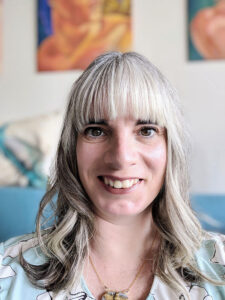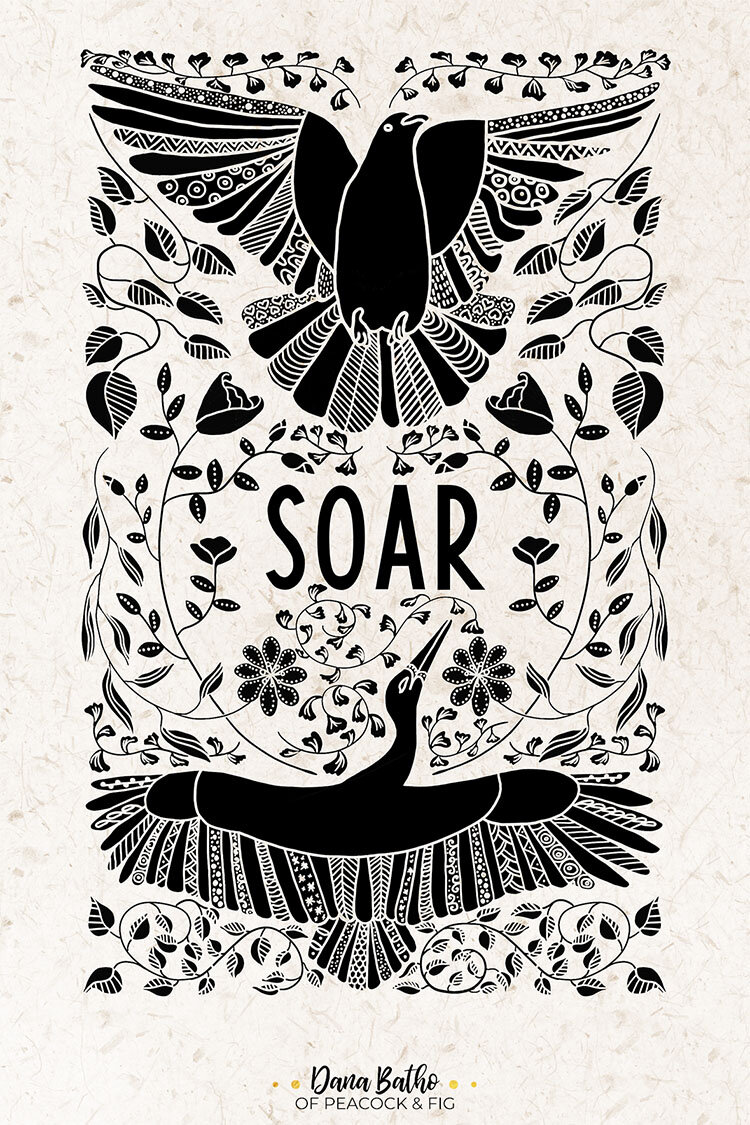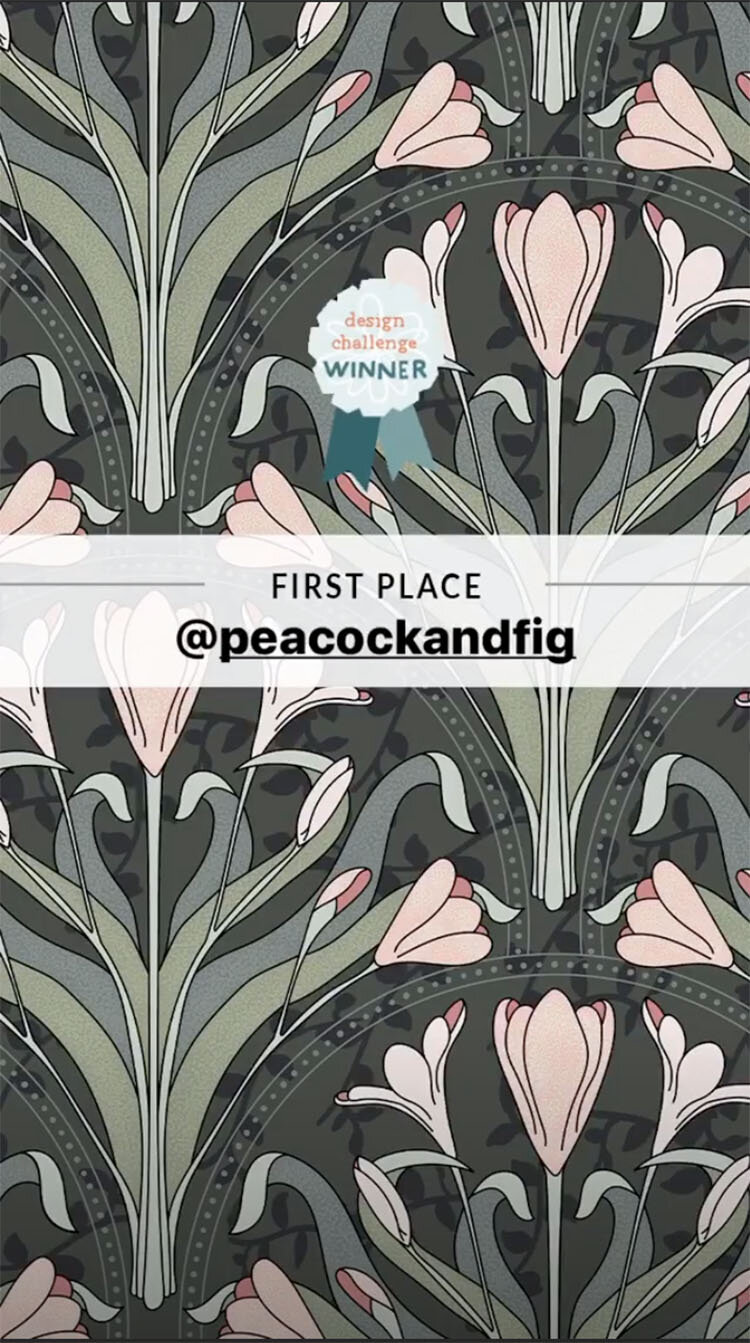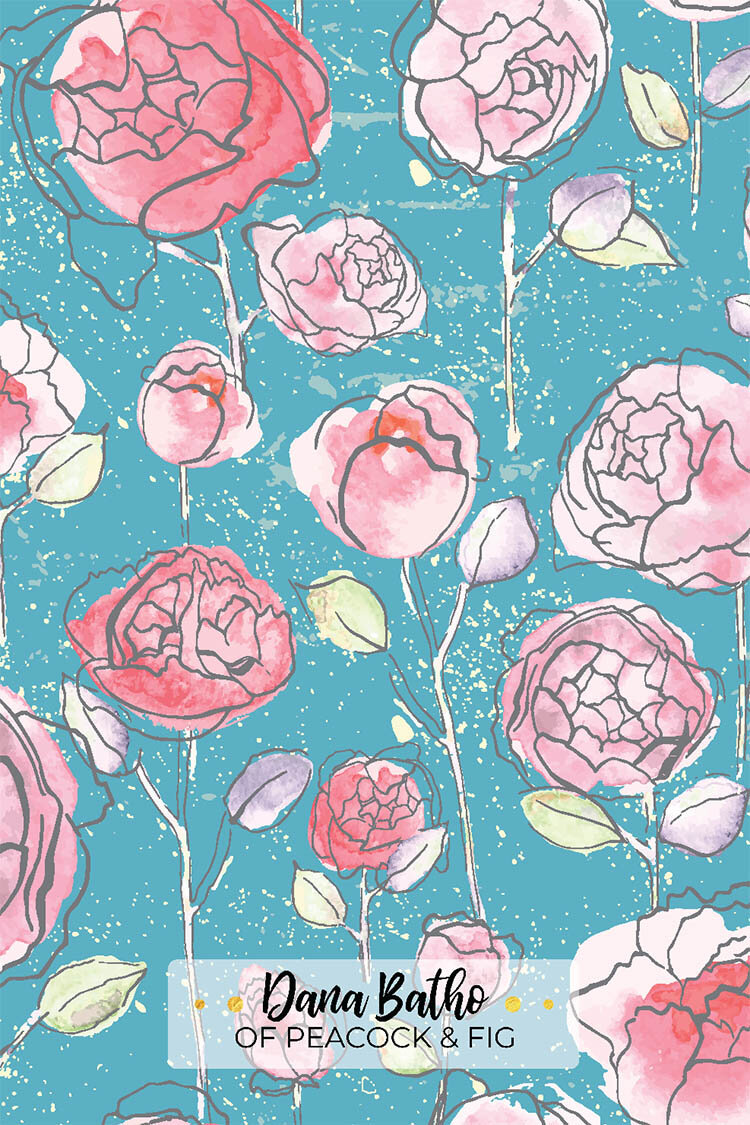Join me in welcoming the spotlight designer for August, the very talented Dana Batho of Peacock & Fig!
Dana is a perfect example of confidence, talent, and tenacity. She’s overcome a lot and has experienced many careers (she’s done everything from being a opera stage manager to working in the military). So while she’s fairly new to the surface design scene, I knew I had to share her story. I’m sure it will inspire you like it did me!
Please Introduce Yourself
 I was born in Wellington, New Zealand, but grew up in Canada (I have dual citizenship). I’ve always done art, and returned to NZ to go to art school, and I returned to art after my military career ended in 2015.
I was born in Wellington, New Zealand, but grew up in Canada (I have dual citizenship). I’ve always done art, and returned to NZ to go to art school, and I returned to art after my military career ended in 2015.
Tell us a little bit about your design journey.
I’ve always been fascinated by textiles and art as my mum is very crafty and taught me how to sew clothes, knit, crochet, draw, etc at a very young age.
After working as a professional stage manager in operas and theatre for several years in Canada and NZ, I attended art school in New Zealand and learned many traditional Polynesian crafts, and I fell in love with textile art and printmaking.
I particularly loved linocut and mezzotint, and I also enjoyed printing my chalk pastel drawings onto silk and then burning the edges, overstitching them on a sewing machine, etc to give them texture and interest.
For the past five years I’ve been working as a cross stitch & embroidery designer and teacher at Peacock & Fig.
I found surface design a year ago when I was looking to branch my pattern designs out into new media and new possibilities. As much as I love designing stitching patterns, surface design and illustration allows me to get so much more detail and texture into my art, and it’s a much faster way for me to work (which is good as I deal with daily chronic pain from an injury that ended my military career, a full cross stitch pattern collection can take months to go from the design stage to ready to sell).
What do you struggle with most as a new designer?
I think at first it’s easy to become intimidated by all the amazing talent out there, and to think that I can’t add one more thing to my repertoire (particularly as someone who does deal with health challenges). But I’m also determined and I don’t give up easily (my general attitude is “challenge accepted” which is even on a bracelet I wear every day).
I think it’s really difficult at first to trust that you can be a unique voice among so much talent, and it’s easy to get influenced by more experienced artists if you’re not careful.
I guess I’m “lucky” in that it’s physically painful for me to scroll Instagram and get too influenced by all the amazing art (as it’s hard for me to look down at my phone), so I’m able to listen to my own voice and hone my viewpoint a bit more “clearly.”

What advice about the surface design industry has been most helpful to you in your career so far?
The book “Real Artists Don’t Starve” is great to bust the assumptions that society holds about artists. To me, it’s important to believe that you can be successful and you can stand out from the crowd.
What has been your favorite client collaboration to date and how did you find them?
Some designs I did have been picked up by a company from a surface design course I did (it was a live design brief as part of the course, I can’t give more details as the designs haven’t been publicly displayed by the company yet), but it was great fun to see some of my designs get attention from a card company.
I’m looking forward to being able to announce that collaboration, as some of the card designs have a lot of sass and are very topical with the global situation we’re all in right now.

When you look back at your design journey so far, what are you most proud of?
I was absolutely stunned that a week after I opened my Spoonflower account and had entered my first design challenge, I won the challenge. It was for Art Nouveau wallpaper, and I absolutely adore that era, so I knew I had to do whatever it took to enter that challenge even though I didn’t feel ready to put a surface design out there publicly yet.
I love the design I created, it’s the most popular in my Spoonflower shop, and I was really proud that it not only made the top fifty with so many entries, it won!
I’m also proud of myself for voraciously learning about the surface design world and how to do it once I’d decided I wanted to pursue it — it’s all too easy to think, “Oh that’d be nice to try, but I have this reason and that reason why now isn’t a good time, why it’s too late for me to try something new, etc.”
I’ve absorbed so much information and done a lot of practicing and training quite quickly, likely a “hangover” from my career as a military intelligence officer where we had to get up to speed on a new threat or issue very fast and be able to take action immediately.
So now even though I’m still quite new to the industry, I feel confident that as long as I keep working and learning and not second guessing myself, I can do this. I’ll be adding more illustration and surface design work soon to my website, but I’m happy with where I am right now as I know I’m on the right path.
Where do you see yourself in your career three years from now?
I’d love to have the opportunity to work on projects with companies like Liberty, Kravet, Pierre Frey — they all have the most incredible art archives.
A lot of my designs are influenced by historical eras so it would be absolutely amazing to be able to access archives like that and see how these companies that have remained relevant for generations work and create new designs.
I’m very interested in wallpaper and high-end home decor like upholstery fabrics and I think it would be fascinating to work with interior designers to create custom designs for client projects.

What advice would you give to surface designers who are struggling?
Think about what you’re struggling with, and find a solution. Is it that you’re not sure of your actual art-making abilities? Take some classes. Skillshare has a wealth of information, and consistently practicing your art is the only way to get better.
Not sure how to manage your business? Again Skillshare has a lot of good resources, as does this website (Shannon’s class on Airtable for Artists is amazing). Or you can take business classes from a local community college or entrepreneurial program.
Suffering from imposter syndrome and think your work isn’t good enough compared to everyone else? Go on a social media break for a few weeks — stop looking at other people’s art and focus only on your voice. If your voice is unique, that’s ok!
People want to hear your unique voice.
And don’t give up! Ask for advice from those you admire (there are many designers and agents you can hire to review your portfolio and give you real feedback on what you need to do), think about the direction you want to go in, and keep your eye on the prize!
Where can we find you?
Website: https://peacockandfig.com
Instagram: @peacockandfig
Wasn’t Dana’s viewpoint so refreshing and encouraging? I’m sure we’ll be hearing some BIG things from her in the future. And if you’d like to be featured on the SDR blog in the future, you can always submit your story right here!